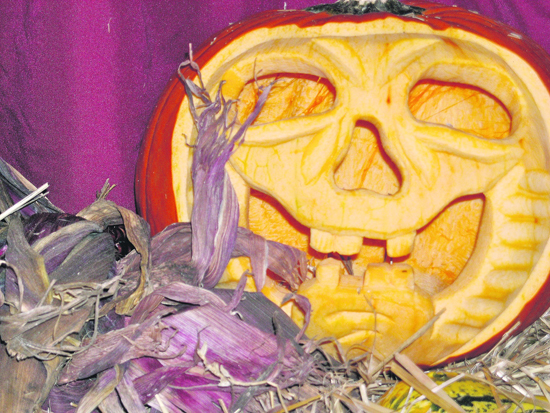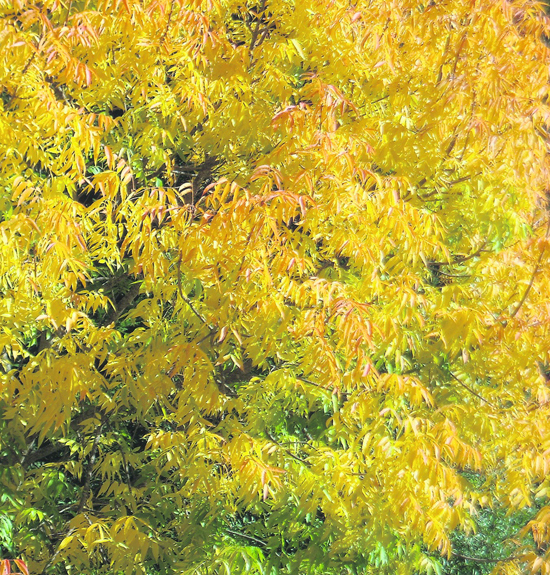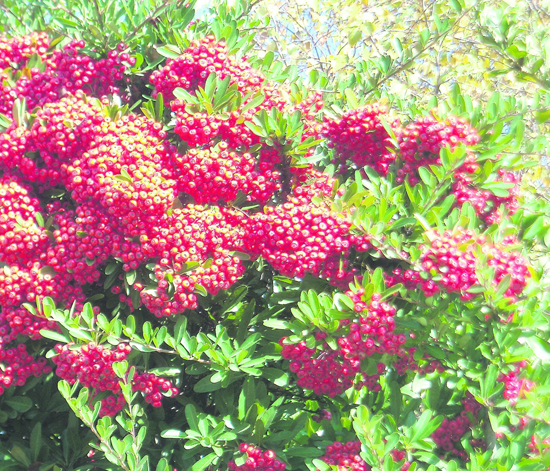| | Published October 26th, 2011
| Thrills, Chills, Gourds, and Ghouls
| | By Cynthia Brian |  | | A smiling Jack O' Lantern and Indian corn Photo Cynthia Brian
| "From ghoulies and ghosties, And long-leggedy beasties, And things that go
bump in the night." Scottish Saying
THRILLS
When our children were young, October was a favorite month because of the traditional weekend we spent with three other families far from the maddening crowds on Mount St. Helena. The location was a hidden Halloween haven, miles from civilization with enough bewitching brilliance to satisfy any ghost. We stayed in a restored historic Victorian from the 1800's with a wrap around porch perched on several acres of pristine forestland dotted with fruit orchards. There was no electricity and water was pumped from nearby springs. Days were spent harvesting vegetables from the massive gardens for our meals, pressing apples into cider, hiking the hillsides, fishing in the creeks, riding horses bareback, and exploring the haunted barn where the creepy crawlies and battalions of bats burrowed.
As the six children carved hordes of pumpkins on the damp meadow, the parents transformed each of the antiquated rooms into a wicked wonderland with ghoulish gourds, floating ghosts, and wailing witches on broomsticks. As dusk turned to darkness with only the flicker from candles, oil lamps, and a star-studded sky, a creepy eeriness permeated the pasture. Shadows terrorized the spider-webbed crevices while the costumed children chowed on spooky servings of spaghetti squash and drank magic juice potions from tombstones and rest in peace goblets. Fearsome and ferocious creatures lurked behind each squeaky door as we adults dressed to thrill our trick or treat offspring with each hesitant knock. The Montesol Halloween's were frightfully fun offering electrifying memories while being completely safe.
The ambling gardens provided the harvest collection of squash, pumpkins, and gourds as the highlight of those October experiences. You can create a comparable Halloween ritual in your own garden by planting gourds galore. Growing is easy. Plan now to directly seed outdoors in full sun after all frost has passed next spring. We can learn from the Native Americans who planted the "Three Sisters" together-corn (maize), squash, and beans. The corn allowed stalks for the beans to climb, the beans added nitrogen to the soil, and the squash provided ground cover and shade for the roots, lessening weed growth. Since squash require large amounts of nitrogen to flourish, after this year's harvest, plant cover crops of crimson clover, hairy vetch, or fava beans to enrich the soil.
Squash has been grown for at least 8,000 years. In the 16th century, the Spanish conqueror of the Incan world, Francisco Pizarro (now that's a great Halloween costume) introduced squash to the European community. Native to South America and Mexico, there are four species of the genus Curcubita. Varieties of edible squash include many zucchinis, crooknecks, spaghetti squash, pumpkins, butternuts, and "pepos" or old world melons. We call them a vegetable, but they are truly a fruit. Cucumbers and many gourds are squash relatives. The wart covered, lavishly colored gourds that decorate our autumn atmospheres are inedible "pepos".
The blossoms of squash are delicious, but make sure you are frying or stuffing the male blossoms and not the female ones or you won't have a crop. Although both blossoms look similar, you can tell the difference because the females have a tiny fruit at the base, which matures into the vegetable we cook, while the males are smooth. Also, don't forget to save seeds both for planting and for enjoying. Dry them for a couple of weeks and roast them for school snacks.
Are you wondering what the differences are between advertised "summer" squash and "winter" squash? Simple, you pick summer squash early, at any size, when the fruit is immature-such as very small zucchini. Winter squash is harvested at full maturity when the stem is brown and frost is looming. Store all squash varieties up to three months in a cool room of 50-60 degrees instead of in the refrigerator. Winter squash recipes abound for your Thanksgiving feast.
Squash and gourds have symbolized the autumn season for centuries because of their varied colors and harvest times in fall. Orange has become the signature color for October and November. Since the origin of the Irish myth of Stingy Jack roaming the dark night with only a piece of fiery coal to light the way, children have been carving scary faces into turnips, potatoes, and of course, pumpkins to illuminate Halloween with the Jack O'Lantern,
As Albert Camus wrote, "Autumn is a second spring when every leaf is a flower." After Halloween, save those uncarved fruits, corn stalks, and hay bales for November adornment. For the Thanksgiving season, a colorful cornucopia of blue, while, and orange pumpkins combined with the multihued gourds, squash, and autumn leaves make a welcome greeting on the doorstep.
CHILLS
A suicide honeybee? Never would have I believed this possible had I not witnessed its desire to drown with my own eyes. In the throes of heat of our Indian summer, I always make sure to keep my garden water elements filled as a cool respite for our flying friends. This week as I filled the fountain, a bee flew into the gurgling froth. Being too deep for a bee to extricate himself (I refer to the bees as male!), I carefully lifted the bee to a nearby leaf with my hand trowel. Two minutes later, the bee dove back into the water. Again, I removed him to a nearby shrub where I watched his behavior. He shook off the dampness, flapped his fairy wings, and nosedived into the water yet again. We repeated our dance thirteen times until I realized I couldn't save him from himself. With colony collapse syndrome a real threat to agriculture and vegetation renewal, why was this honeybee determined to die? Was his demise due to the unlucky number thirteen, or was he forecasting the arrival of ghost bees in our bonnets!
Enjoy the thrills, chills, gourds, and ghouls. Carve a pumpkin with wolves howling at the full moon, hear the churchyards yawn, and grab your broomstick for the witching hour. Happy Hallowed Eve! Boo!
|
 | | The saffron and burnt umber shades of the pistache tree.
|
Cynthia Brian's Gardening Guide for November
No shade, no shine, no butterflies, no bees, no fruits, no flowers, no leaves, no birds - November! ~Thomas Hood, "No!"
November is not as dire as Thomas Hood writes, yet, with the falling leaves, the chilly winds, and shorter days of sun light, we understand that Mother Nature is bedding down for the upcoming winter. Whether you build a big bonfire on the driveway, play croquet on the lawn, or listen to the sighing of the soil, be a humble pilgrim while experiencing a grateful gathering with friends and family on Thanksgiving Day.
- ATTRACT lizards by raking leaves and brush into a pile. The shelter invites these helpful reptiles to your garden.
- ALLOW a smattering of spent rose blooms to develop rose hips. Excellent for tea as a vitamin C booster.
- DEADHEAD the rest of your roses as the petals fade to maintain a steady stream of colorful, fragrant bouquet through the New Year.
- COLOR your world by planting bushes that boast fall and winter berries such as cotoneaster, holly, and pyracantha. Robins may get drunk on the red berries, while migratory birds are grateful for the nutritious fuel.
- MULCH by shredding the raked leaves from the deciduous trees adding grass clippings, dried plants stems, and trimmings all which provide water conservation, better drainage, and nutrients to the soil.
- DECORATE your front door with a wreath made from gourds, tiny pumpkins, and autumn leaves. Add a witch or goblin for a spooky Halloween, then, for Thanksgiving switch to a wood cut out
of pilgrims or turkeys plus Indian corn, apples, and nuts. One arrangement doubles as a star cornucopia for fall fun.
- DISCOVER trees that tickle your fancy with their brilliant fall foliage at your local nurseries. When you see trees dressed in their full autumn attire, it's easier to choose ones that best suit your garden. Make sure to consider size, sun, and spread when buying a tree.
- ADD texture, color, and all season interest to your landscape by planting low maintenance ornamental grasses such as purple fountaingrass, arching maidengrass, blue fescue, or the popular, upright feather reedgrass.
- STAY ALERT for brush fire danger. As you cut branches and rake leaves, keep them far from your home and other burnable structures. Despite recent rains, fires happen when the winds kick up.
Clean your chimney before igniting your wood burning fireplaces. Twenty years ago at this time in 1991, the East Bay hills witnessed one of the most devastating late season fires in history.
- PLANT your spring blooming bulbs now including daffodils, crocus, tulips, and other favorites. You'll be able to continue planting bulbs through January. Mark the location with plant tags or
wooden paint sticks.
- PERK up your optimism quotient with perennials that energize, soothe, and lift your mood. It's planting time for Oriental Poppies, Peonies, and Bearded Iris.
- LOOKING for an extravagant gift for that special someone? You can have a rose commissioned with their name for fees beginning around $9500. Roses are registered with the International Cultivar Registration Authority.
I'd love a Starstyle(r) rose, but it may have to wait. Darn! If you have the bucks, visit http://paulzimmermanroses.com/?page_id=1141.
- PICK up acorns that fall from the oak trees before they take root. Put them in a pile outside of your garden fence to feed the deer and the squirrels.
- ROAST sweet potatoes with sliced garlic, chopped hazelnuts, sprigs of rosemary tossed with olive oil and balsamic for a savory sweet treat. Top with peppery arugula and nasturtium blossoms picked from your garden.
- CLOSE your garage and shed doors as you enter and leave to avoid unwanted intruders such as slithering serpents and rambling rodents who are anxious to bed down for a long winters nap.
(Experience on this one, most certainly!)
- PAMPER our feathered friends with clean nesting boxes and plenty of food. As the weather changes, they appreciate a little help from humans.
- SUBJECT your Christmas cactus to cold temperatures in the 50's or leave pots of them in the dark for 12 hours a day to encourage holiday blooms.
- WINTERIZE your patio by covering or storing furniture, pads, and accessories Move frost tender plants in pots near the house for warmth.
- BREATHE in the chilly air on a clear day as you savor the season's final blossoms and scented flower fragrances. Winter is drawing near.
- GRATITUDE works. My heartfelt thank you to all of you who read my column faithfully. Wishing you a healthy holiday and terrific Thanksgiving.
Happy Gardening to YOU!
(c)2011 Cynthia Brian
The Goddess Gardener
Cynthia@GoddessGardener.com
www.GoddessGardener.com
925-377-7827
My virtual door is always open. I am available as a
speaker and consultant. Feel free to contact me..
|
 | | Pyrancantha berries beckon the birds to dine!
| | | | | | | | | Advertisement | | |
| | | print story
Before you print this article, please remember that it will remain in our archive for you to visit anytime.
download pdf
(use the pdf document for best printing results!) | | | Comments | | |
| | | | | | | | | | | | | | | | |




